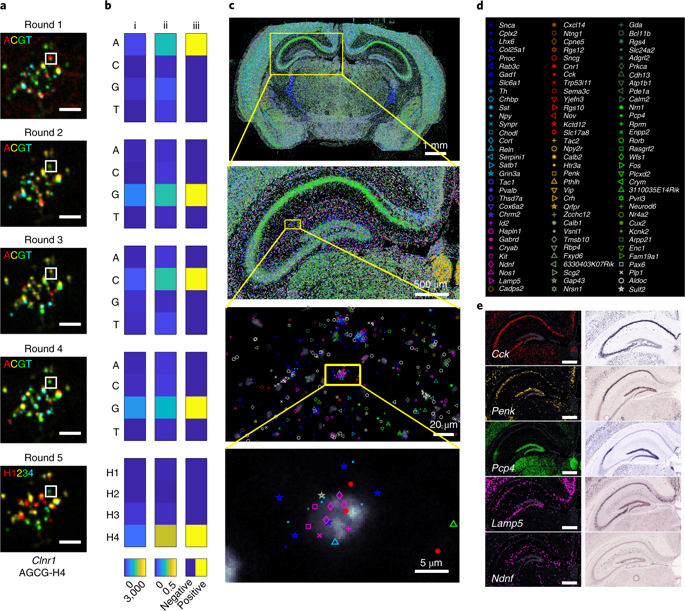当前位置:
X-MOL 学术
›
Nat. Methods
›
论文详情
Our official English website, www.x-mol.net, welcomes your
feedback! (Note: you will need to create a separate account there.)
Probabilistic cell typing enables fine mapping of closely related cell types in situ.
Nature Methods ( IF 36.1 ) Pub Date : 2019-11-18 , DOI: 10.1038/s41592-019-0631-4 Xiaoyan Qian 1 , Kenneth D Harris 2 , Thomas Hauling 1, 2 , Dimitris Nicoloutsopoulos 2 , Ana B Muñoz-Manchado 3 , Nathan Skene 2, 3 , Jens Hjerling-Leffler 3 , Mats Nilsson 1
Nature Methods ( IF 36.1 ) Pub Date : 2019-11-18 , DOI: 10.1038/s41592-019-0631-4 Xiaoyan Qian 1 , Kenneth D Harris 2 , Thomas Hauling 1, 2 , Dimitris Nicoloutsopoulos 2 , Ana B Muñoz-Manchado 3 , Nathan Skene 2, 3 , Jens Hjerling-Leffler 3 , Mats Nilsson 1
Affiliation

|
Understanding the function of a tissue requires knowing the spatial organization of its constituent cell types. In the cerebral cortex, single-cell RNA sequencing (scRNA-seq) has revealed the genome-wide expression patterns that define its many, closely related neuronal types, but cannot reveal their spatial arrangement. Here we introduce probabilistic cell typing by in situ sequencing (pciSeq), an approach that leverages previous scRNA-seq classification to identify cell types using multiplexed in situ RNA detection. We applied this method by mapping the inhibitory neurons of mouse hippocampal area CA1, for which ground truth is available from extensive previous work identifying their laminar organization. Our method identified these neuronal classes in a spatial arrangement matching ground truth, and further identified multiple classes of isocortical pyramidal cell in a pattern matching their known organization. This method will allow identifying the spatial organization of closely related cell types across the brain and other tissues.
中文翻译:

概率细胞分型可以在原位对密切相关的细胞类型进行精细定位。
了解组织的功能需要了解其组成细胞类型的空间组织。在大脑皮层中,单细胞 RNA 测序 (scRNA-seq) 揭示了定义其许多密切相关的神经元类型的全基因组表达模式,但无法揭示它们的空间排列。在这里,我们通过原位测序 (pciSeq) 介绍了概率细胞分型,该方法利用先前的 scRNA-seq 分类来使用多重原位 RNA 检测来识别细胞类型。我们通过绘制小鼠海马区 CA1 的抑制性神经元来应用这种方法,其基本事实可从之前广泛的识别其层状组织的工作中获得。我们的方法在匹配地面实况的空间排列中识别了这些神经元类,并以与其已知组织相匹配的模式进一步确定了多类等皮质锥体细胞。这种方法将允许识别大脑和其他组织中密切相关的细胞类型的空间组织。
更新日期:2019-11-18
中文翻译:

概率细胞分型可以在原位对密切相关的细胞类型进行精细定位。
了解组织的功能需要了解其组成细胞类型的空间组织。在大脑皮层中,单细胞 RNA 测序 (scRNA-seq) 揭示了定义其许多密切相关的神经元类型的全基因组表达模式,但无法揭示它们的空间排列。在这里,我们通过原位测序 (pciSeq) 介绍了概率细胞分型,该方法利用先前的 scRNA-seq 分类来使用多重原位 RNA 检测来识别细胞类型。我们通过绘制小鼠海马区 CA1 的抑制性神经元来应用这种方法,其基本事实可从之前广泛的识别其层状组织的工作中获得。我们的方法在匹配地面实况的空间排列中识别了这些神经元类,并以与其已知组织相匹配的模式进一步确定了多类等皮质锥体细胞。这种方法将允许识别大脑和其他组织中密切相关的细胞类型的空间组织。











































 京公网安备 11010802027423号
京公网安备 11010802027423号